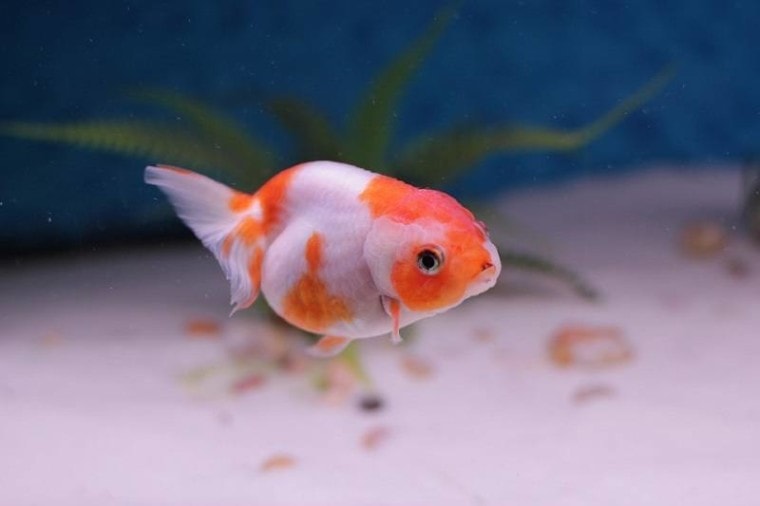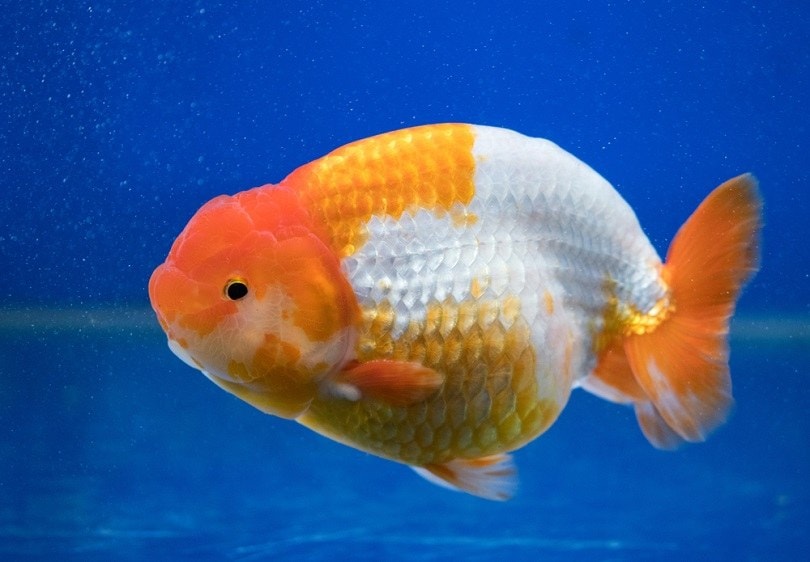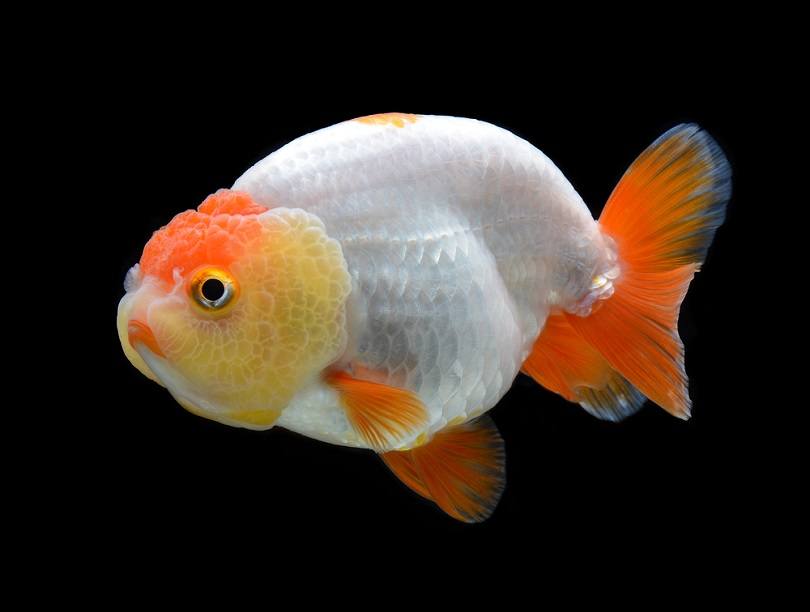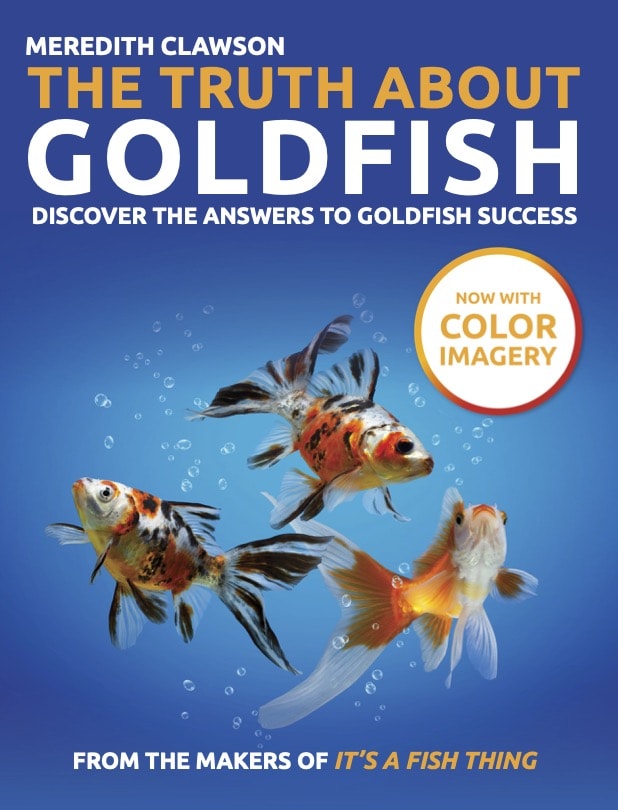Ranchu Goldfish: Care Guide, Varieties, Lifespan & More (With Pictures)

Introduction
Ranchu Goldfish are unique and unusual looking, they come in a variety of colors, shapes, and sizes. They have the potential to grow large and live long under appropriate care conditions. Ranchus make a great addition to slow-moving, fancy goldfish tanks that are stocked and decorated appropriately with a necessary filter and aerator. Below we will discuss the care requirements and necessary information on caring for this type of goldfish appropriately.

Quick Facts about Ranchu Goldfish:

| Species Name: | Carrassius auratus |
| Family: | Minnows and Carps |
| Care Level: | Moderately difficult |
| Temperature: | 65°-77°Fahrenheit |
| Temperament: | Social and peaceful goldfish who will benefit greatly from a compatible tankmate |
| Color Form: | Red, calico, combinations of red and white or gold and white |
| Lifespan: | Approximately 10-15 years |
| Size: | 5”-8” |
| Diet: | Omnivorous, both vegetables and protein are consumed in order to obtain overall health. |
| Minimum Tank Size: | 10 gallons for one full-grown adult Ranchu and an additional 5 gallons per tankmate |
| Tank Set-Up: | safe and smooth decorations to avoid unnecessary injury but enough to add security within the tank |
| Compatibility: | Suitable with most slow-moving, fancy goldfish, not ideal with other species of fish or fast-moving, slim-bodied goldfish |
Ranchu Goldfish Overview
An interesting and unique feature in identifying these goldfish is the fact that they have no dorsal fin and instead grow a wen, which is a large head growth. This compromises their ability to control their bodies when swimming, making them more slow-moving and even requiring resting periods throughout the day to regain energy to swim appropriately.
They are one of the most peaceful yet handicapped goldfish due to their anatomy. Health-wise, they are more susceptible to swim bladder disorder than most other slim-bodied goldfish due to their overly stocky and rounded body shapes.
They are not a common goldfish seen in most pet stores and are typically ordered from a reputable breeder who breeds good genetic lines in terms of body and general health. They require at least one compatible tankmate in order to thrive and feel more social and secure within an appropriately decorated and stocked tank.
Extra care is advised due to the Ranchu’s more delicate nature and body, They can become stressed if they are kept in a bare, unfiltered, and understocked tank. These fish need a carefully-planned diet to avoid swim bladder disorder and any related health issues.
How Much Do Ranchu Goldfish Cost?
However, for non-competing fish, the price range is anywhere between 5-25 dollars and varies due to the availability, age, size, and source. Buying from a pet store will generally be cheaper due to the high shipping costs of delivering live animals.

Typical Behavior & Temperament
These peaceful fish are social and slow-moving by nature. They can commonly be seen foraging at the substrate for any leftover food during the day. You may also notice them taking a short rest by either sitting at the bottom of the tank or hovering in the water. They are curious and love to explore and investigate their surroundings. You will notice their endearing swimming behaviors which include wiggling around the tank and a seeming eagerness to explore.
Appearance & Varieties
come in a variety of colors, each one uniquely patterned and colored with metallic scales. Keep in mind their colors may fade or change throughout their lifetime. While they can take on many colors, they are most often bi-colored, with combinations of red and white as well as gold and white being most common.
As mentioned, they grow a raspberry-shaped wen on top of their heads, so do not be alarmed when you notice such a growth developing. In fact, sometimes it can even cover their eyes, which contributes to their lack of agility.

How to Take Care of Ranchu Goldfish
Habitat, Tank Conditions & Setup
Are Ranchu Goldfish Good Tank Mates?
Ranchus are not the most appropriate tankmates for the majority of fish, including some types of fast-moving goldfish. They have a very compromised body type and therefore have trouble moving around. Given that their wen can grow over their eyes and affect eyesight, they can be ill-equipped at finding food before the other fish, leading to stress and malnutrition.
They do not make good community fish and should not be paired with other species of fish or fast, slim-bodied goldfish due to bullying, fin nipping, or resource competition within the tank. They get along and do best with slow-moving, same-sized goldfish so they do not have to compete for food or be at risk of fin nipping.
What to Feed Your Ranchu Goldfish
Ranchus require a varied and healthy diet to remain in optimal health. They are at risk for swim bladder disorder so a diet of floating food should be avoided so they do not take in unnecessary air at the surface.
Good quality flakes, sinking pellets, or gel food should be fed along with suitable vegetables to help keep maintain a healthy digestive system and body function.
Many goldfish die as a result of improper feeding, diet, and/or portion sizes – which can be easily prevented by proper education.

That’s why we recommend the best-selling book, The Truth About Goldfish, which covers everything about goldfish nutrition, tank maintenance, illnesses & more! Check it out on Amazon today.
Make sure to remove any uneaten food to avoid fouling the water and having rotting food in the tank, which will cause an ammonia spike. Do not feed your Ranchu too much but make sure each fish gets an adequate amount of food. Keep the food dosage to what they can consume within 2 minutes.
Keeping Your Ranchu Healthy
You can keep your Ranchu happy and healthy by making sure they have good water conditions. This requires running a good filter, having adequate aeration, and keeping the tank cycled. Only do partial water changes when necessary.
Feeding a good-quality, portioned diet is essential to raising and keeping a healthy fish. Keep them away from loud noises and tank jostling or frequent quick movements to avoid stress. Make sure to appropriately house your Ranchu in desirable conditions with peaceful and compatible tankmates. A stress-free Ranchu is a healthy and happy one. Correct care is essential to making this happen.
Breeding
In the wild, Ranchu breed in the spring when the temperature is right and there are appropriate mates. Goldfish, in general, should be ready to breed between 1-2 years old and will spawn in warmer water conditions when they are kept healthy.
The males will show they are ready to breed by displaying breeding stars, You will also observe the males chasing the females, displaying goldfish breeding behavior.
Make sure the females are not constantly chased and stressed out by the males’ behavior. If this happens, it’s best to use a tank divider and separate the genders. When breeding season and age comes along, make sure your tank has enough visual barriers and appropriate hiding places to avoid the constant stress of mating behaviors.

Are Ranchu Goldfish Suitable For Your Aquarium?
If you keep a tank with the appropriate size and stocking rate and own or plan to own a variety of slow-moving, round-bodied goldfish, a Ranchu will fit right in. As long as you keep If you keep an appropriate filter and aeration system, provide smooth decorations and feed a varied and healthy diet, you will be rewarded with the pleasure of owning a Ranchu Goldfish who will make a colorful and cute addition to an appropriate tank.
If you have all the above care guidelines ticked, then you are ready to go and get your Ranchu Goldfish and keep a healthy aquarium! The most important is compatible tank mates and the decorations that are smooth, and any opening are big enough for your Ranchu to swim through.
Related Read: Ranchu vs Lionhead Goldfish: Which Breed is Right for You?

Featured Image Credit: TDesigns, Pixabay



Không có nhận xét nào